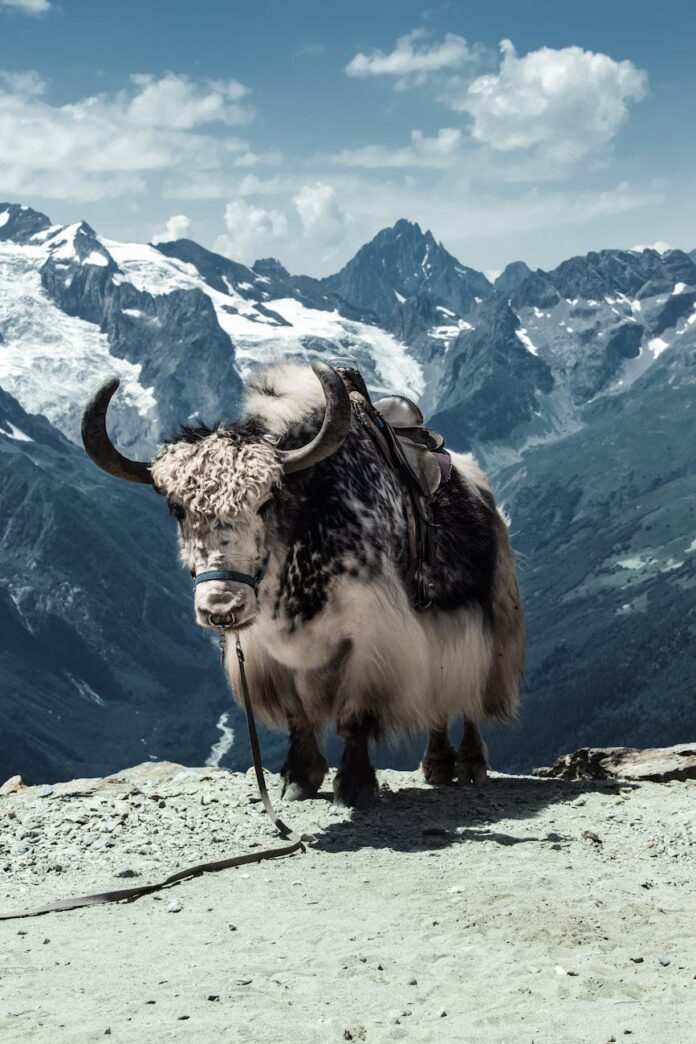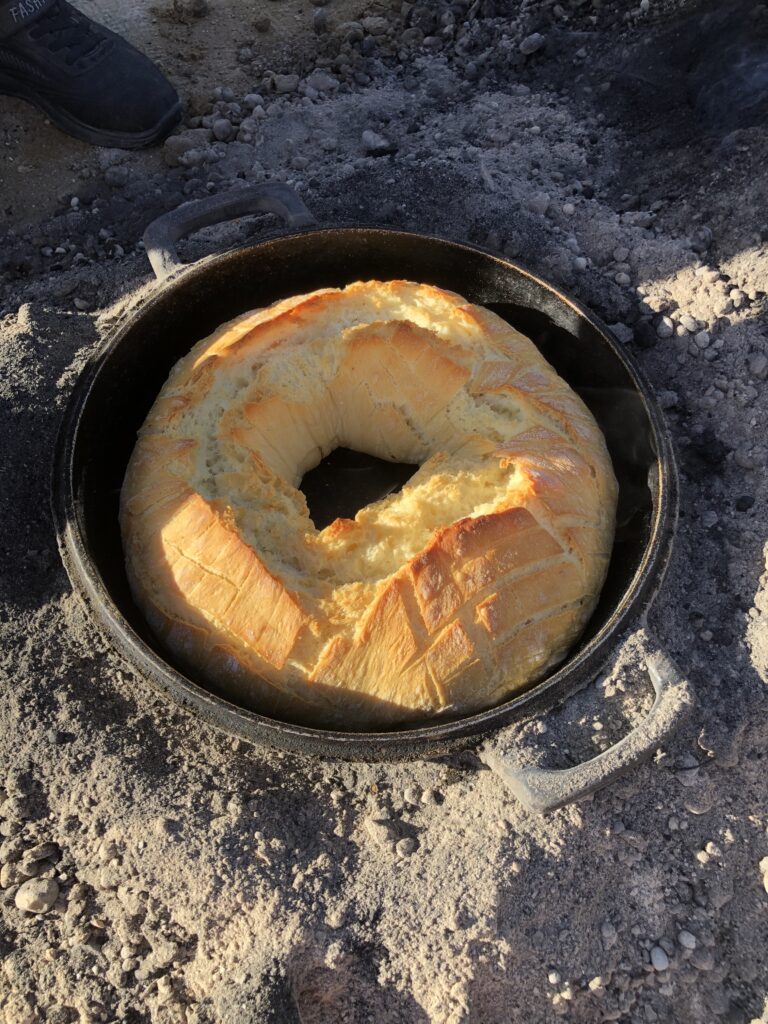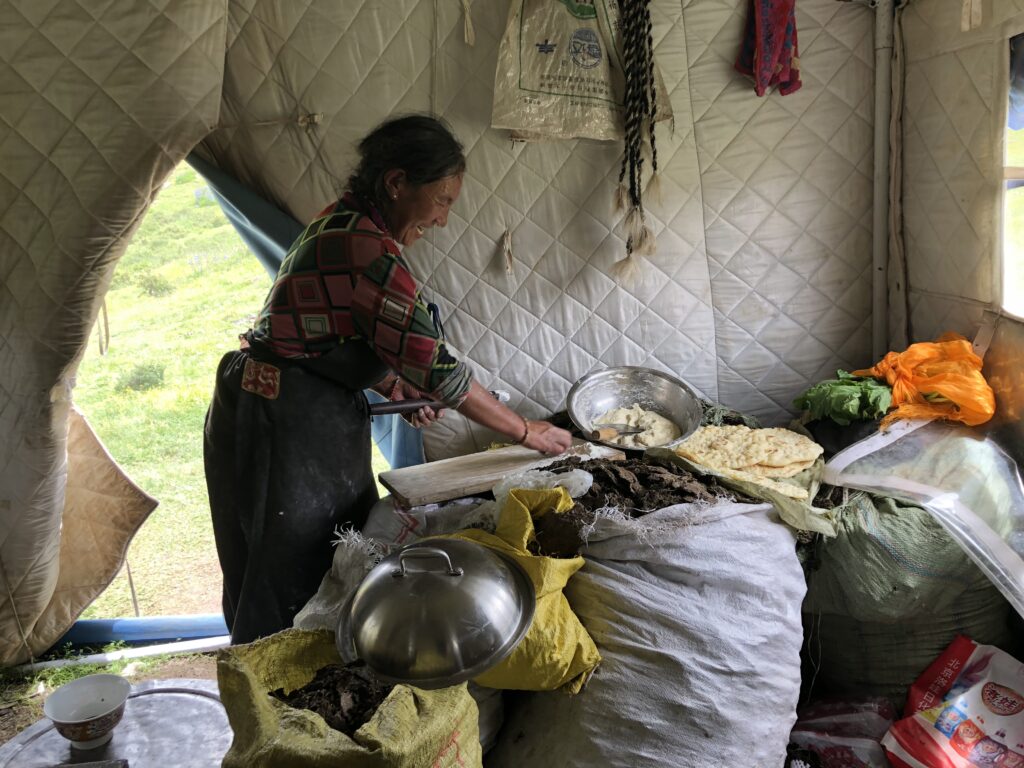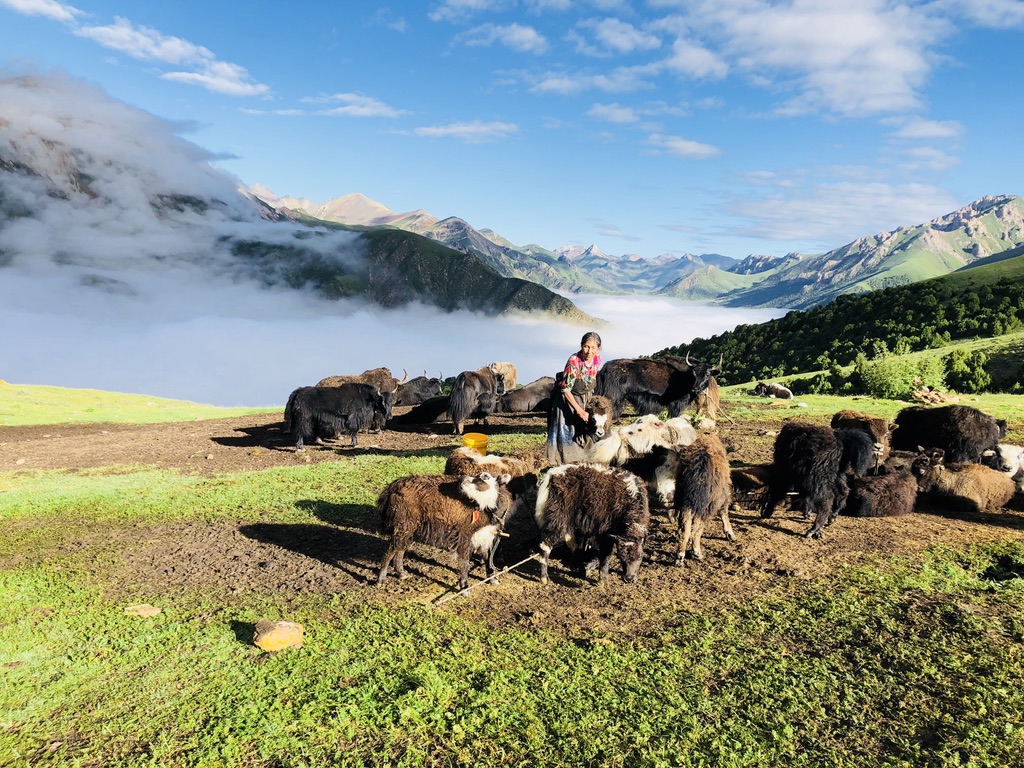
By Ying Wang, UW-Milwaukee Associate Professor of Art History
“Are these cinders?” I asked my Tibetan teacher while staring at a smoking charcoal-like slag pile. “No. They are the remains of a burnt sheep-dung fuel, for fire, used instead of firewood,” my teacher answered. When his sister-in-law pushed the fuel aside, a black cast-iron cooking pot appeared. A lovely round and ring-shaped bread was inside with a fresh baked fragrance coming from it as soon as the lid was lifted. I was surprised (Fig.1). This method of using sheep-dung fuel to bake the ring-shaped bread is unique to the Amdo region in northern Tibet.1 The ring-bread is made with yeast, is fluffy, and looks like a huge bagel. Amdo also has traditional flat pita bread made on a flat pan, which is a method that can be seen all over the world. But this way of cooking ring-bread differs from any other part of Tibet, and Eurasia generally.

This essay attempts to introduce the general lifestyle of the semi-nomadic herdsmen in the Amdo and Kham regions of Qinghai in Tibet through their use of yak and sheep-dung fuels for cooking, based on my fieldwork.2 In Amdo, horses, yak, and sheep, in particular, are the most important livestock, while in Kham, yak is the main herd. The main food sources for the people in these regions are ground barley wheat powder (rtsam-pa), milk products, and meat. Both live in the grassland with a pastoral life, Ando and Kham people share many similarities but both have their distinctive lifestyle and dialect.3
Dung is vital for survival in the grassland. The most popular material for fuel is yak-dung, mostly for strong, quick cooking. Just like the Tibetan language has fine-grained terminology for the different stages of maturity of these animals, so as yak-dung: the yellow-colored dried dung of late autumn, those flat pieces used to cover the outer façade of walls to keep heat inside during winter and outside during summer, those picked up from the top of mountains or flat-land, those from the season when grass was not strong, etc. Its value, said in a folksong: “Yak-dung, you are much precious than gold, burning yourself and bringing warmness and light to humans.”
Only the dung of naturally-fed animals can be used as fuel. Since it mainly consists of fiber from fresh grass, it smells like grass and burns without much smoke. For those animals raised in “modern” farms and fed manufactured provender, their dung is smelly, useless, and without shape. Tibetans’ lives are so dependent on the yak and sheep that they are virtually members of the family. All body parts of the animal are useful: their meat is beloved food, bones are used to make soup, some parts of the bone can be carved into utensils and praying beads, skin is used for making footwear and hats, and wool is used for weaving and knitting. Indeed, the traditional Tibetan tent is woven from yak wool. Both yak and sheep can be used to carry goods. It is a splendid picture to view animal transportation at work. The lifestyle of the herdsmen, whether nomadic or semi-nomadic, is self-sufficient and environmentally friendly. Perhaps most importantly, being a nomad or semi-nomad, one is proud and free.4
During my fieldwork, I lived with a semi-nomadic Kham family. The mistress of the family, Amala, was an intelligent woman of about 60 years old. She would make flat pita-like bread daily using yak-dung fuel for the fire. It was always a lovely moment when we added flat yak-dung bricks to the stove. The flame would rise, lighting up the tent, and fire stars would blink. This bread is of a thin crust made without yeast and the dough was simply placed on a flat iron pan without oil. She rolled the dough on a wooden board, the same as anywhere in the world. But where she placed the board was on a sack of yak-dung (Fig. 2).

Amala brought up her two biological children and six orphan kids from a deceased relative, alone. She took care of 70 yaks on a large pasture located in the mountains, with the help of her grown-up son Ding-duor and three magnificent mastiffs. She got up to milk the yaks before sunrise, pick up the yaks’ dung in the afternoon while watching the herds, cook both the noon and evening meals, and make milk products at night. She would also clean yak wool and knit it once in a while. She used a large fork to put the yak dung in a basket she carried on her back and brought it back near the tent. This dung was flattened and scored to be broken up into thin bricks and smoothed out until fully dried. The dried dung would be put into large bags and then moved inside the tent (see Fig. 2). Making a fire for daily living requires collecting a large amount of dung, and properly arranging it for drying so that it is no longer just dung but useful material.
Amala repeated these chores daily and her only free time, if it occurred at all, would be in the late afternoon. She and her daughter would sit together reading the Buddhist sutra before cooking dinner. It was usually flatbread and barley powder mixed with milk or butter (rtsam-pa). At night, she would churn a huge flask of milk for hours making butter and buttermilk. All the work is labor intensive.5 I never saw Amala rest until deep in the night. She would pray in a full body prostration as soon as she woke up and before she went to bed. Tibetan women have no time to rest.
Sometimes, Amala’s nephews would live with us. Although they were physically strong, not one of them offered even a finger to help with the work mentioned above. I asked her daughter why these young men do not help Amala. She answered that men cannot do housework because it would be shameful. Men are important for protecting the household. Without a strong man in the family, the pastureland could be seized by bad neighbors—a real threat even now. These are the gender roles of the grassland. Men are too proud to do any work except for herding and fighting, but this is a crucial job to protect the household and to enable the animals to rove on the land. Women are free to marry, divorce, or enter into polyandry (have more than one husband). About my Kham family, Amala was such a special woman in charge of the land for decades as the house mistress (Fig. 3).6
The beautiful environs and relatively larger land for Herdsmen to move around gives them a kind of independence. They are closer to nature and the sacred landscape. There are so many mountains, water, and rocks, that are believed to be sacred relating to Buddhism and nature worship.7 Each family also has their own sacred place, which could be a few pieces of rock or a special valley. This spiritual link between nature and religion is an important part of Tibetan life.
Nature and all beings are respected in this grassland, including animal dung. Yak-dung symbolizes wealth and happiness and is used in many ritual practices. This great compassion is not only because they are the most important livestock but also due to the Buddhist belief in the life circle, samsara. From everyday labor work with the animals— feeding them grass and milking, to collecting dung and purifying them through fire —the human-animal and grassland bond is strong. The dung fuel is emblematic of this connection. Even when herdsmen are forced to settle in living a sedentary life, the cooking method goes on. The use of dung fuel is eco-sufficient, healthy, and environmentally clean—nothing is taken from nature, and nothing is wasted. Everything from nature is respected and everything from the grassland returns to grassland. Just as the delicious ring-bread baked with dung-fuel brings enjoyment and energy to people and connected their life to the circle of nature. It not only forms the traditional way of living in the Tibetan grassland but also indicates the pride of the free nomadic spirit.
1 Historically, Tibet constitutes three regions: U-Tsang (Central Tibet includes the capital Lhasa), Amdo in the western part of current Qinghai and Gansu Provinces; and Kham which is the east part of Qinghai, part of Sichuan and Yunnan provinces. In Qinghai Province on today’s map, the Amdo region is on the west (ca.10000 ft. altitude) and the Kham is on the east (ca.14000ft.).
2 Semi-nomadic means that there are two regular pastures to farm, summer and winter, rather than traveling freely.
3 Now, however, all herdsmen are being forced to give up their traditional lifestyles and cultures due to the Chinese government’s view that pastoral life is backward.
4 Thomas Barfield, The Perilous Frontier: Nomadic Empires of China 221BC to AD 1757. Hoboken New Jersey: Wiley-Blackwell,1992. In terms of freedom, there was no way to tax a nomad traditionally, although other substitutes may apply. Nomads proudly enjoy their lifestyles without the bondage of agricultural land as peasants.
5 Melvyn Goldstein, Nomads of Western Tibet: The Survival of a Way of Life. University of California Press, 1990.
6 Amala’s two children came from two men of different periods; both abandoned them when the kids were very young. Amala held the farm as the housemaster alone during the past decades.
7 Gesha Gelek Jinpa, Charles Ramble, et al. Sacred Landscape and Pilgrimage in Tibet: In search of the Lost Kingdom of Bon. Abbevilles Press, 2005.
Bibliography
Barfield, Thomas, The Perilous Frontier: Nomadic Empires of China 221BC to AD 1757. Hoboken New Jersey: Wiley-Blackwell, 1992
Goldstein, Melvyn, Nomads of Western Tibet: The Survival of a Way of Life. University of California Press, 1990
Jinpa, Gesha Gelek, Charles Ramble, Charles, et al. Sacred Landscape and Pilgrimage in Tibet: In search of the Lost Kingdom of Bon. Abbevilles Press, 2005
Ying Wang, Associate Professor of the Department of Art History, UWM. PhD. Department of History of Art and Architecture, University of Pittsburgh. Fields of Teaching: Art History of East Asia. Primary area of research: Bronze Age China, Tibet, and related art and cultures. Recent publications: “The Guge Kingdom and the Jesuit’s Mission in Tibet.” in East Asia, Yuan, Ming, Qing Dynasties. Ed. by Noriko Miyazaki, and Masahide Mori, in a twelve-volume project Buddhist Art of Asia, edited by Miyaji Aki, Nagoya University of Japan, 2022. “Thog-Icag, Search for the cultural origins of the Tibetan Bronze artwork,” in Memorial Essays for Prof. Li Xueqin. Ed. Research and Conservation Center for Excavated Texts, Tsinghua University, Beijing, 2021. p. 479-502






